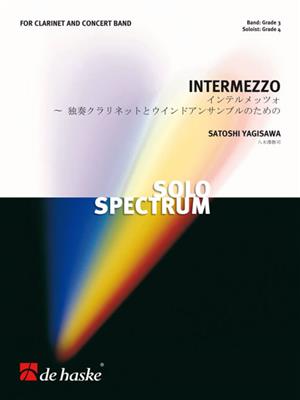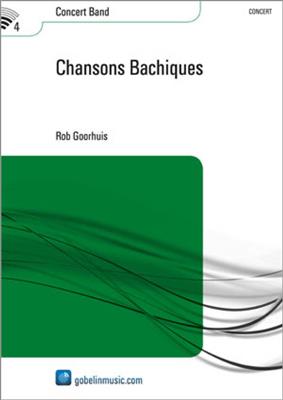Results
-
£118.99
Fiddle Tunes - James Curnow
Fiddle tunes have been an important part of American music since her earliest days. You'll enjoy James Curnow's new suite based on two fiddle tunes from the Revolutionary War period. The first movement uses the flowing melody Lovely Nancy, which is about a beautiful two-masted sailing ship. The second movement comes from a knee-slapping fast paced dance tune called Hay Makers.This will be a wonderful contrast piece to use for that lighter moment in your concert. It's always fun to explore band music that is a bit out of the ordinary! This one is great fun from beginning to end and carries a marvelous historic connection as well!
Estimated dispatch 7-14 working days
-
 £244.99
£244.99Les Voyages de Gulliver - Maxime Aulio
Maxime Aulio composed Les Voyages de Gulliver (Gulliver's Travels) for the concert band of the Conservatoire National de Rgion in Toulouse (France) conducted by Jean-Guy Olive. The first performance took place in Toulouse (Auditorium Saint-Pierre des Cuisines) on April 25, 2001. The Anglo-Irish author Jonathan Swift (1667-1745) took about six years to complete his epic tale of adventure. The creative storyline, clear writing and subtlety of Gulliver's Travels have been engaging readers for generations. This literary travel between reason and foolishness was Maxime Aulio's inspiration for this piece. Each of the four movements of this suite is a review of Gulliver'sadventures, resembling the effect of a kaleidoscope, which juxtaposes small fragments of colour in a linear pattern.
Estimated dispatch 7-14 working days
-
 £102.99
£102.99Latin ABC - Peter Kleine Schaars
Latin ABC is a suite in three movements inspired by the music of the Caribbean. The first movement is a joyful Curaaon waltz, the second movement a sensual, slow salsa: a style that is popular on the island of Bonaire. Finally, Latin ABC culminates with a rousing march that brings the listener to sunny Aruba. This work is suitable for Grade 3 players, and showcases the percussion section in particular.
Estimated dispatch 7-14 working days
-
 £104.99
£104.99Intermezzo - Satoshi Yagisawa
Intermezzo is the second movement of Satoshi Yagisawa's Clarinet Concerto. The concerto was first performed by Higashi-Hiroshima Wind Ensemble in Hiroshima, Japan in 2010 with guest performer Shinsuke Hashimoto, clarinettist with the Hiroshima Symphony Orchestra and was conducted by Atsushi Kageyama. Inspiration for this work came from the fact that both Satoshi Yagisawa and Shinsuke Hashimoto graduated from Musashino Academia Musicae.Clarinet Concerto>/I> is the pinnacle of Satoshi Yagisawa's "Concerto Series" which also features his Suite Concertante for Piano and WindOrchestra, Trumpet Concerto, Trombone Concerto, Saxophone Concertino, andConcertino for Solo Percussion and Wind Orchestra.Yagisawa's characteristic heartfelt theme in the second movement is especially popular and consequently--entitled Intermezzo--it is often performed independently.Soloist: Grade 4
Estimated dispatch 7-14 working days
-
 £55.00
£55.00Shelter Island. Wind band - Nigel Hess
Commissioned in 1985, 'East Coast Pictures' has become a modern classic for all wind bands. 'Shelter Island' is the first movement of the suite. The music conjures up a vivid picture of this small island, moving from a crowdedsummer tourist trap to the onslaught of the Atlantic during the winter.
Estimated dispatch 7-14 working days
-
 £154.99
£154.99Chansons Bachiques - Rob Goorhuis
In this four-movement suite, every moment sings of a different type of French wine. All these wines have their origins in the little French village of Savigny-les-Beaune in Burgundy and are made by wine-grower Pierre Guillemot. It was theexcellent quality of the wines that inspired Rob Goorhuis into writing this composition. The first three movements deal with three red wines made of the Pinot Noir grape which all bear the Premier Cru designation. The final movement wasinspired by a white wine made of Pinot Blanc and Chardonnay. In the nature of their musical material, the various movements not only give a characterisation of the taste of the wines. they also hint at impressions of the respective vineyards andtheir surroundings. 1st Movement Les Narbantons - Giocoso 2nd Movement Les Jarrons - Gracioso 3rd Movement Les Serpentieres - Festivo 4rd Movement Dessus des Golardes - Vivaci.
Estimated dispatch 7-14 working days
-
 £293.00
£293.00Three Dance Episodes (from On the Town) - Leonard Bernstein
The 1944 musical On the Town represents Leonard Bernstein's first venture onto the Broadway stage. Inspired by his successful ballet Fancy Free, the musical follows the adventures of three sailors on shore leave in New York Cityand is focused around a series of dance episodes, three of which Bernstein selected for an orchestral suite. Long unavailable for band, this 2016 edition is beautifully transcribed by Paul Lavender. Dur: c. 11:00
Estimated dispatch 7-14 working days
-
 £129.99
£129.99Aquarium - Johan de Meij
The Suite 'Aquarium' is Johan de Meij's third composition for symphonic band and features six tropical fishes, each of them represented by a motif, and surfacing as such in several guises. The composition consists of three movements of which the second and third merge uninterruptedly into each other. I) Allegretto grazioso (Neon Tetra, Electric Eel and Angelfish) II) Andante / Adagio (Sea Horse and Zebrafish) III) Finale: Allegro giocoso (Guppy & Co.) The Neon Tetra motif functions as a kind of 'Leitmotiv' and descibes the beautifully coloured, frisky fish: A number of variants have been derived from this theme and will also appear in the other movements.The Electric Eel in fact is not represented by a motif, but by a rhythm based on the restless electric pulses made audible in some aquaria. The Angel fish is represented by elegant cluster chords. In the second movement the Sea Horse emerges out of the water vegetation and starts a dialogue with the Zebrafish, which is represented by one melodic phrase in unison, getting more and more threatening by added parallel fifths and octaves. Simultaneously with the Sea Horse motif the Neon Tetra theme emerges, this time in 3/4 time and in Eb minor. The third movement starts with only two instruments (trumpet and xylophone), but as it is often the case with Guppies their number rapidly increases. Piccolo and Alto Saxophone introduce the Guppy Theme followed by several instrumental combinations. Every theme from the first movement 'swims by' once more, after which the principal motif leads us to a brilliant ending.
Estimated dispatch 7-14 working days
-
 £134.99
£134.99Gulliver's Travels - Bert Appermont
The book Gullivers Travels (1726) by author Jonathan Swift formed the provocation for writing this composition. Even though this composition isnt a literal representation of the original story, a number of elements were still retained. The shipsdoctor Gulliver finds himself in 4 (fictive) areas, each with their own inhabitants and customs. Each part of this suite also received the name of one of these areas:I. Lilliput The enterprising Lilliputians are represented by a playful, common themein the first part.II. BrobdingnagIn the land of "Brobdingnag" Gulliver is carried off by gigantic giants, which you hear approaching with the sounds of the bassinstruments. The same theme is constantly repeated and quickened in order to increase thetension.III. LaputaLaputa is an island that floats in the air; its inhabitants are strange people with slanting heads. The dreamy, special atmosphere is especially well conveyed here.IV. The HouyhnhnmsFinally Gulliver finds himself in the land of theHouyhnhnms, where intelligent and noble horses rule over the primitive, undeveloped people (yahoos). The trumpets in the brilliant opening express the galloping horses; the gallant theme that follows (horns and trombones) symbolises the primitiveyahoos. The whole composition ends with a big finale.I intentionally tried to limit the degree of difficulty of Gullivers Travels. Despite this I think that this work can appeal to many orchestras due to the colourful orchestration (cues areprovided where needed), the simple and clear theme and the highly imaginative breeding ground of a beautiful story around which this composition is built."
Estimated dispatch 7-14 working days
-
 £53.50
£53.50Palladio - Karl Jenkins
Although this composition sounds like it came straight out of the Baroque period, it is actually the first movement of a suite written in 1996 by Karl Jenkins. Instantly recognized as the 'diamond commercial' theme, its relentless pulse and dramatic nature make it a natural for bands. Robert Longfield's skilled arrangement puts it within reach of most groups.score and parts - 4 Flute I, 4 Flute II, 2 Oboe, 4 Bb Clarinet I, 4 Bb Clarinet II, 4 Bb Clarinet III, 2 Bb Bass Clarinet, 2 Bassoon, 2 Eb Alto Saxophone I, 2 Eb Alto Saxophone II, 2 Bb Tenor Saxophone, 2 Eb Baritone Saxophone, 2 F Horn I, 2 F Horn II, 3 Bb Trumpet I, 3 Bb Trumpet II, 3 Bb Trumpet III, , 3 Trombone I,3 Trombone II, 2 Baritone B.C., 2 Baritone T.C., 4 Tuba, I String Bass, I Timpani, 2 Percussion I, 2 Percussion II - wind/concert band
Estimated dispatch 7-14 working days
